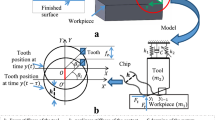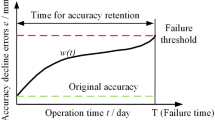Abstract
Cyber physical system (CPS) requires modeling and virtual simulation of machining processes. Among the many physical quantities simulated by CPS, the cutting force is one of the most important quantities to be simulated. Until now, two fundamental challenges in achieving a functional and virtual machining process simulation system remain—the identification of cutter workpiece engagement (CWE) along a tool path and the development of computationally efficient simulation algorithms. The major bottleneck is the prerequisite requirement to calculate the complex CWE area before calculating the instantaneous cutting force. In this research, we propose an innovative solution to this problem. Using graphics processing unit’s (GPU) parallel computing on the direct computation of the instantaneous cutting force (without calculating CWE), the cutting force computation, together with NC simulation, can reach up to 48 fps on a local PC, reaching the goal of CPS and digital twin simulation requirements in real time.
















Similar content being viewed by others
Availability of data and material
Data and material can be available upon request.
Code availability
Code can be available upon request.
References
Altintas Y (1992) Prediction of cutting forces and tool breakage in milling from feed drive current measurements. J Eng Sci Med Diagn Ther 114(4):386–392
Albertelli P, Goletti M, Torta M, Salehi M, Monno M (2015) Model-based broadband estimation of cutting forces and tool vibration in milling through in-process indirect multiple-sensors measurements. Int J Adv Manuf Syst 82(5–8):779–796
Ferry WB, Altintas Y (2008) Virtual Five-Axis Flank Milling of Jet Engine Impellers—Part II: Feed Rate Optimization of Five-Axis Flank Milling. J Manuf Sci Eng 130(1)
Altintas Y, Yang J, Kilic ZM (2019) Virtual prediction and constraint of contour errors induced by cutting force disturbances on multi-axis CNC machine tools. CIRP Ann 68(1):377–380
Salehi M, Albertelli P, Goletti M, Ripamonti F, Tomasini G, Monno M (2015) Indirect model based estimation of cutting force and tool tip vibrational behavior in milling machines by sensor fusion. Procedia CIRP 33:239–244
Matsumura T, Tamura S (2017) Cutting force model in milling with cutter runout. Procedia CIRP 58:566–571
Merdol SD, Altintas Y (2008) Virtual simulation and optimization of milling applications—Part II: Optimization and Feedrate Scheduling. J Manuf Sci Eng 130(5)
Erdim H, Lazoglu I, Ozturk B (2006) Feedrate scheduling strategies for free-form surfaces. Int J Mach Tools Manuf 46(7–8):747–757
Merdol SD, Altintas Y (2008) Virtual simulation and optimization of milling applications—Part I: Process Simulation. J Manuf Sci Eng 130(5)
Spence A, Altintas Y (1994) A solid modeller based milling process simulation and planning system
Mounayri HE, Spence AD, Elbestawi MA (1998) Milling process simulation—a generic solid modeller based paradigm. ASME J Manuf Sci Eng
Boz Y, Erdim H, Lazoglu I (2010) Modeling cutting forces for 5-axis machining of sculptured surfaces. In 2nd International Conference Process Machine Interactions 1
Guzel BU, Lazoglu I (2004) Increasing productivity in sculpture surface machining via off-line piecewise variable feedrate scheduling based on the force system model. Int J Mach Tools Manuf 44(1):21–28
Gong X, Feng H-Y (2016) Cutter-workpiece engagement determination for general milling using triangle mesh modeling. J Comput Des Eng 3(2):151–160
Comak A, Altintas Y (2017) Mechanics of turn-milling operations. Int J Mach Tools Manuf 121:2–9
Habibi M,Tuysuz O, Altintas Y (2019) Modification of tool orientation and position to compensate tool and part deflections in five-axis ball end milling operations. J Manuf Sci Eng Trans 141(3)
Habibi M, Kilic ZM, Altintas Y (2021) Minimizing flute engagement to adjust tool orientation for reducing surface errors in five-xis ball end milling operations. J Manuf Sci Eng 143(2)
El-Mounayri H, Elbestawi M, Spence A, Bedi S (1997) General geometric modelling approach for machining process simulation. Int J Adv Manuf Syst 13(4):237–247
Imani B, Sadeghi M, Elbestawi M (1998) An improved process simulation system for ball-end milling of sculptured surfaces. Int J Mach Tools Manuf 38(9):1089–1107
Bailey T, Elbestawi MA, El-Wardany TI, Fitzpatrick P (2002) Generic simulation approach for multi-axis machining, Part 1: Modeling Methodology. J Manuf Sci Eng 124(3):624–633
Fussell BK, Jerard RB, Hemmett JG (2003) Modeling of cutting geometry and forces for 5-axis sculptured surface machining. Comput Aided Des 35(4):333–346
Engin S, Altintas Y (2001) Mechanics and dynamics of general milling cutters. Part1: helical end mills. Int J Mach
Moufki A, Dudzinski D, Le Coz G (2015) Prediction of cutting forces from an analytical model of oblique cutting, application to peripheral milling of Ti-6Al-4V alloy. The International Journal of Advanced Manufacturing Technology 81(1–4):615–626
Habibi M, Kilic ZM, Altintas Y (2021) Minimizing flute engagement to adjust tool orientation for reducing surface errors in five-axis ball end milling operations. J Manuf Sci Eng Trans 143(2):021009
Tukora B, Szalay T (2012) Multi-dexel based material removal simulation and cutting force prediction with the use of general-purpose graphics processing units. Adv Eng Softw 43(1):65–70
Inui M, Kobayashi M, Umezu N (2018) Cutter engagement feature extraction using triple-dexel representation workpiece model and GPU parallel processing function. Computer-Aided Design and Applications 16(1):89–102
Funding
The authors express their thanks to the Ministry of Science and Technology of Taiwan for the funding support (Grant number [MOST 110–2221-E-194–038]).
Author information
Authors and Affiliations
Contributions
All authors contribute equally to the theoretical development and experimental design and implementation of this work.
Corresponding author
Ethics declarations
Ethics approval
The authors declare that the content of this work is original and there is no conduct of violating the principle of ethics in this work.
Consent to participate
The authors were granted and approved to participate in this work.
Consent for publication
The authors give full consent to the publisher for the publication of this work.
Conflict of interest
The authors declare no competing interests.
Additional information
Publisher's Note
Springer Nature remains neutral with regard to jurisdictional claims in published maps and institutional affiliations.
Rights and permissions
About this article
Cite this article
Yau, HT., Wang, SY., Chang, HC. et al. Direct computation of instantaneous cutting force in real-time multi-axis NC simulation. Int J Adv Manuf Technol 119, 6967–6978 (2022). https://doi.org/10.1007/s00170-021-08545-7
Received:
Accepted:
Published:
Issue Date:
DOI: https://doi.org/10.1007/s00170-021-08545-7




